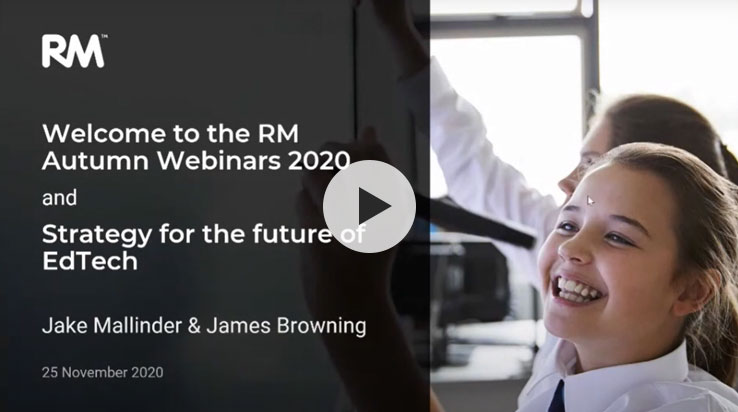As midnight struck at the close of 2019, none of us could have known that within a few short months we’d be closing our schools to all but a few; that we’d all soon be familiar with terms such as ‘remote teaching and learning’, ‘virtual classrooms’ and ‘asynchronous and synchronous online learning’. The pandemic changed the way we use technology in education rapidly, radically and in some ways irrevocably, accelerating a trend that had already begun.
With technology forming such an integral part of all other areas of our life – at home and at work, for leisure, convenience, and productivity, it was inevitable that sooner or later, technology would come to take a greater place in education. Now, as we across the UK return to face-to-face, in-school teaching and learning, we have an opportunity to ‘build back better’, to retain those elements of remote learning that worked well, to use technology as part of a blended approach, to helping students catch up with lost learning, and to prepare the ground for any future periods of disruption. To do this well, we must build specific consideration of EdTech into our long-term school improvement strategies.
Watch the opening webinar from our recent RM Seminar series: Strategy for the future of EdTech.

In spite of some early enthusiasm from schools looking to equip pupils with individual devices as early as 2013, technology has until now occupied a limited role in terms of pupils personally using ICT in the classroom. This has many explanations, ranging from the ideological to the purely practical. There may be a sense that technology is damaging or usurping skills that we have long considered to be natural and essential, such as the ability to read and digest long texts, and to write legibly using pen and paper. When schools returned after the first national lockdown due to the pandemic, the decline in handwriting was one of the most noticeable casualties of online learning, anecdotal evidence suggests. And there is no shortage of research and evidence into the decline of reading stamina among more recent generations, seemingly caused by the ascendancy of screens and fast-moving media. The ways in which young people read and prefer to learn are changing, and many educators may be unsure whether the cultural shift that technology influences is always a positive one.
Combining the best of both worlds
The challenge perhaps is to capitalise on the ‘new’ – the potential of technology to enhance teaching and learning while preparing pupils and students for the modern world – while also retaining the best of the ‘old’. We can embrace technology, in the understanding that STEM skills are increasingly in demand and will be crucial to our children’s success when they enter the workplace, while still doing everything in our power to keep things like reading for pleasure high on the agenda – to keep flying the flag for ‘real’ reading, for novels and plays and poetry that give us insight into human experience, develop our empathy and broaden our horizons.
We can investigate and adopt new EdTech solutions that enrich our pedagogical and curriculum design while still understanding that there is no substitute for the real-life interaction between a teacher and pupil, or, indeed, between peers. It goes without saying that teachers can support students’ learning in a way that computers cannot – gradually and skilfully scaffolding learning and fanning the flames of interest and understanding in nuanced and reactive ways. Yet technology can act as a second pair of hands – an electronic Teaching Assistant that can help students practise, apply, review, revisit. It can be used to be motivate, to appeal to different learning styles or preferences, to give students a private space to make mistakes and receive instant feedback. It can be used to give teachers granular insight into students’ progress, enabling them to address areas of weakness in future sessions.
Practical barriers to better EdTech
While it is crucial that teachers and leaders consider in sufficient depth how technology can help them achieve their vision for their school or for their subject, improve outcomes for students, reduce workload for teachers and bring about benefits for specific segments within the school community, it is equally important for leaders to consider the practical implications. A device in every student’s hand is no good if the WiFi doesn’t reach into every classroom, the broadband is inadequate to the task and your server is about to fall over. A top-notch infrastructure is no use if students are lacking the hardware, or if the hardware is old and frequently needs charging or fixing (In 2019 nearly a third of computing devices in schools were deemed ineffective due to age, specification or condition). All the tech in the world is no use if the culture within the school is resistant, or if there simply hasn’t been enough discussion or training on how to incorporate technology into daily teaching. Using a school-wide digital platform like Microsoft 365 or Google Workspace for Education to manage homework and remote learning is no good if the students and parents don’t know how to properly use or engage with it, or if they don’t have devices at home. Here we come back to the practical barriers to greater adoption of technology in school, namely budget and expertise.
A strategic approach to school ICT
The 2020 BESA ICT report showed that two-thirds of primary and secondary schools upwardly revised ICT investments in 2020, but nearly half of the schools said they were unlikely to be able to maintain ICT investments into 2021/22. Among secondary school respondents, 66% cited the challenge of securing funds as one of the most pressing ICT concerns over the next 12 months, with 52% also citing the need to ensure teachers have adequate access to training.
With the ongoing pressure on school budgets, spend on technology has to be balanced with other critical resource spend. Better technology can feel out of reach or a luxury, a ‘wish list’ rather than a realistic prospect. It is crucial therefore in your strategic planning to develop a clear set of priorities to support your overall vision, to consider the cost (both financial and educational) of acting now versus later, and to research deals and offers you may be able to access.
Meanwhile, only 40% of primary schools and 47% of secondary schools surveyed by BESA reported that they were completely or mostly supported by providers of technology and digital content over the past year, with an indication that academies are being better supported than authority schools. Whether you have access to in-house tech support and ICT management or are reliant on external suppliers, best use of your human resources therefore needs to be another key consideration in the development of your technology strategy.
Bringing in external help
Working with a large technology partner such as RM may be the answer to both of these problems. Though it might seem counterintuitive from a budgetary point of view, working with RM could save you money in the long run through their wealth of expertise in all areas of technology provision, economies of scale and in-depth knowledge of available funding and rebates. We can help schools create a detailed business plan to support your technology expansion and amortise set-up costs. Read about RM’s work with Vickerstown Primary School (https://www.rm.com/blog/2021/march/vickerstown-primary-and-brambles-nursery-school) to discover how RM helped them catch up on their ICT investment to strengthen their ability to improve the education of their pupils.
“We did not want to stagnate as a school. This solution gave us the leap that we needed. We now need to keep evolving – keep learning”.
David Holmes, Headteacher

For further advice and support on creating your school EdTech strategy and ensuring it receives the status it requires take a look at our recent Strategy for the Future of EdTech webinar.
